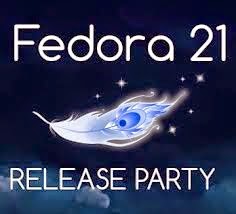It was a fine Sunday afternoon on 21st December, when me along with some of the brightest minds from FOSS community of Mumbai joined together at Homi Bhabha Institute of Science Education to celebrate the release of Fedora 21 Operating System, one of the most respected and loved open source project for its true support and adherence to the FOSS philosophy.
Fedora 21 is the first release of the OS that is part of the Fedora.Next initiative, which fundamentally changes the way the OS is packaged and released. In the history of 11 years, Fedora has been shipped as a monolithic OS image catering to all of its users without focusing on any particular use-case scenarios. This got changed with Fedora 21. Now the distribution produces 3 distinct products based on its target audience. These are:
- Fedora Workstation: The product featuring the Gnome 3 environment focusing on the desktop and workstation users including developers, designers as well as casual computer users using computers for learning, work and fun.
- Fedora Server: Fedora Server focuses on, well, server use cases. This product basically has capabilities to setup any kind of server scenario be it a DNS server, File server, FTP server or Mail server. It doesn't feature a desktop environment by default, because who needs that on a server anyways? Cockpit and FreeIPA are two fabulous tools for server and identity management that I simply love, and are included by default. This product does a good job in reducing the attack surface (believe me, even on Linux we have such things :) ) by adhering to less-by-default philosophy and allowing admins to setup specific functionalities by choice in setup as well as afterwards.
- Fedora Cloud: My understanding of the cloud environments is limited, however, I can tell you that Fedora Cloud is an image of Fedora OS that ready to be deployed directly to many of the popular cloud service providers including Amazon, OpenStack etc and has support for Docker and Project Atomic Host. The kernel packages in Fedora 21 have been separated into core and modules, and since the cloud image never runs on metal, the modules part is not included making the image size ideally small.
- The Spins: Yes, Yes I said 3 products but I will give you one more anyway :) Although not officially publicized that much, Fedora project also features Spins, DVD images specifically tailored for various desktop environments other than Gnome. The list of spins includes the KDE spin, MATE spin, XFCE spin, LXDE Spin and Sugar Desktop Environment spin to name a few. So you are not locked to Gnome, go, have fun with whatever you like. It’s an open source OS, remember?
The Speakers
The event featured some brilliant speakers who gave powerful informative sessions throughout the day. The list includes:
- Pravin Satpute: Pravin opened the event with a warm welcome and told us about the history of Fedora, how it all started at Redhat and the Fedora.Next initiative. It was a nice ride down the memory lane for us oldies and a nice primer about the "Fedora Way" for new comers.
- Anish Patil: Anish's talk focused on the new features in Fedora Workstation product including the shiny new Gnome 3.14, new applications introduced in it, the powerful developer-centric features like dev assist and the awesome Gnome-Software application management tool. He also introduced new people to the Gnome UX and cleared some misconceptions or “Myths” that are common about Fedora. We were all impressed!
- Praveen Kumar: One of my favorites, Praveen took the stage next and satisfied my thirst for information about cloud computing and how Fedora Cloud product fits in. He described the basic functioning of a cloud infrastructure as well as Project Atomic and OpenStack integration in Fedora. I was jumping with joy when he described the Docker-IO feature integration and Kubernetes and how it can help application programmers in deploying and delivering their solutions effectively. Awesome!
- Rahul Bhalerao: Rahul is a really nice, soft spoken, mild guy, well suited for the next item in the agenda, How to contribute to Fedora Project. This topic was people centric and required him to motivate people enough to contribute to the project in their spare time for free. Well, they do get other people’s work in Fedora as a return so I will not say it’s free; it’s a giving-back-to-the-community program actually. Needless to say, Rahul's talk was very effective and audience was quite excited in the end. He also told the step by step method to get involved and the Dos and Don'ts of working on a community based project.
Post the talks, we had an open session where we poured our hearts out loud and had a healthy and power packed with knowledge discussion with all the attendees. The event was also graced by the presence of Professor Nagarjun G of Tata Institute of Fundamental Research, who is a well known figure in open source world and a contributor and the magic mind behind many great projects. Professor Nagarjun gave us a great deal of knowledge about the FOSS philosophy, the difference between FOSS and OSS and discussed in details the problems of monolithic, centralized projects owned by single companies and how distributed FOSS projects can help. It was a wonderful experience meeting this brilliant mind :)
Well, yes there were tasty snacks as well in between with tea sessions and everybody had fun I think at that, along with some college students who were not there in the sessions I guess :D Everybody was heartily welcome!
Cheers!




No comments:
Post a Comment